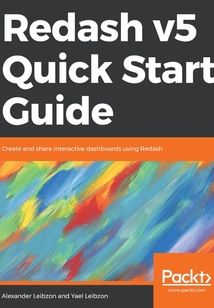舉報(bào) 

會員
Redash v5 Quick Start Guide
DataexplorationandvisualizationisvitaltoBusinessIntelligence,thebackboneofalmosteveryenterpriseororganization.Redashisaqueryingandvisualizationtooldevelopedtosimplifyhowmarketingandbusinessdevelopmentdepartmentsareexposedtodata.IfyouwanttolearntocreateinteractivedashboardswithRedash,exploredifferentvisualizations,andsharetheinsightswithyourpeers,thenthisistheidealbookforyou.ThebookstartswithessentialBusinessIntelligenceconceptsthatareattheheartofdatavisualizations.YouwilllearnhowtofindyourwayroundRedashanditsricharrayofdatavisualizationoptionsforbuildinginteractivedashboards.Youwilllearnhowtocreatedatastorytellingandsharethesewithpeers.Youwillseehowtoconnecttodifferentdatasourcestoprocesscomplexdata,andthenvisualizethisdatatorevealvaluableinsights.Bytheendofthisbook,youwillbeconfidentwiththeRedashdashboardingtooltoprovideinsightandcommunicatedatastorytelling.
目錄(158章)
倒序
- 封面
- Title Page
- Copyright and Credits
- Redash v5 Quick Start Guide
- Packt Upsell
- Why subscribe?
- PacktPub.com
- Foreword
- Contributors
- About the authors
- About the reviewer
- Packt is searching for authors like you
- Preface
- Who this book is for
- What this book covers
- To get the most out of this book
- Download the example code files
- Conventions used
- Get in touch
- Reviews
- Introducing Redash
- Data challenges experienced by companies on a daily basis
- An example dashboard
- Ideal tools for targeting challenges
- Meeting Redash
- What exactly is Redash?
- Redash architecture
- Summary
- Installing Redash
- Sizing – choosing the right machine to do the job
- Installation options and installation walkthrough
- Installation options
- AWS-predefined image
- Launching an instance using Redash AMI
- Launching an instance using Bitnami Redash AMI
- Welcome to Redash setup page
- GCE-Predefined image
- Docker-based installation
- Provisioning script installation
- Explaining the setup.sh script
- Troubleshooting
- Configuration and setup
- Email configuration
- Using Google OAuth to log in to Redash
- Redash environment settings
- HTTPS (SSL) Setup
- Permissions in Redash
- Groups
- Creating and editing groups
- Creating users
- Summary
- Creating and Visualizing your First Query
- Creating and testing the Data Source
- Alternative static Data Source definition
- Creating your first query
- Creating the visualization
- Creating the dashboard
- Summary
- Connecting to Data Sources
- Supported Data Sources
- Adding a new Redash Data Source
- A detailed walk-through of the selected Data Sources
- Connecting to PostgreSQL
- Connecting to ElasticSearch
- Connecting to MongoDB
- Connecting to GoogleSpreadsheet
- Connecting to Url
- Connecting to Query Results (beta)
- Connecting to Amazon Athena
- Connecting to BigQuery
- Connecting to Redshift
- Connecting to DynamoDB
- Summary
- Writing and Executing Queries
- Query listing
- Query editor overview
- Query operations
- Creating a query
- Editing a query
- Forking a query
- Archiving a query
- Scheduling a query
- Query results and filters
- Query results
- Query filters
- Parametrized queries
- Parameter settings
- Query snippets
- Alerts
- Alert statuses
- Creating Alerts
- Alert destinations
- Summary
- Creating Visualizations
- The benefits of visualizations
- An overview of visualization types
- Boxplot
- Chart
- Map (Choropleth map)
- Cohort
- Counter
- Funnel
- Map (Markers map)
- Pivot table
- Sankey
- Sunburst sequence
- Word cloud
- Table
- Visualizations in action
- Creating and editing visualizations
- Going over Redash visualizations
- Boxplot
- Chart
- Map (Choropleth)
- Cohort
- Counter
- Funnel
- Map (Markers)
- Pivot Table
- Sankey
- Sunburst sequence
- Table
- Word Cloud
- Special actions on visualizations
- Summary
- Dashboards and Practical Tips
- Dashboard how-tos
- Creating/editing dashboards
- Dashboard query filters hashtags and favorite dashboards
- Dashboard-level filters
- Dashboard hashtags
- Favorite Dashboards
- Sharing dashboards
- Dashboard guidelines
- Tips and tricks
- Summary
- Customizing Redash
- Redash API
- API authentication
- API calls overview
- API usage examples
- Extending Redash code
- Installing Redash for development
- Installing a Docker-based developer environment
- Initial dev setup
- Dev use
- Installing a regular developer environment
- Installing dependencies
- Installing the necessary Python packages
- Node.js packages and assets
- Redash configuration
- Creating Redash operational database tables
- Starting Redash's main processes
- Running tests
- Connecting to the remote server while running the frontend locally
- Summary
- Other Books You May Enjoy
- Leave a review - let other readers know what you think 更新時間:2021-08-13 15:12:39
推薦閱讀
- 軟件架構(gòu)設(shè)計(jì)
- Blockchain Quick Start Guide
- Effective DevOps with AWS
- 視覺檢測技術(shù)及智能計(jì)算
- B2B2C網(wǎng)上商城開發(fā)指南
- AWS Certified SysOps Administrator:Associate Guide
- Word 2007,Excel 2007辦公應(yīng)用融會貫通
- 工業(yè)機(jī)器人力覺視覺控制高級應(yīng)用
- 大數(shù)據(jù)導(dǎo)論
- Cloudera Hadoop大數(shù)據(jù)平臺實(shí)戰(zhàn)指南
- Deep Learning Essentials
- Apache Spark Quick Start Guide
- 機(jī)器人剛?cè)狁詈蟿恿W(xué)
- Embedded Linux Development using Yocto Projects(Second Edition)
- SketchUp 2014 for Architectural Visualization(Second Edition)
- 數(shù)據(jù)庫技術(shù):Access 2003計(jì)算機(jī)網(wǎng)絡(luò)技術(shù)
- Practical Internet of Things with JavaScript
- ORACLE數(shù)據(jù)庫技術(shù)實(shí)用詳解
- 超限學(xué)習(xí)機(jī):理論、技術(shù)與應(yīng)用
- AVR單片機(jī)菜鳥進(jìn)階
- TensorFlow深度學(xué)習(xí)應(yīng)用實(shí)踐
- Spark MLlib機(jī)器學(xué)習(xí)實(shí)踐(第2版)
- Office戰(zhàn)斗力
- 人工智能基礎(chǔ)
- Hands-On Internet of Things with Blynk
- Docker Bootcamp
- 從計(jì)算機(jī)集成制造到智能制造:循序漸進(jìn)與突變
- Hands-On Recommendation Systems with Python
- Flink原理、實(shí)戰(zhàn)與性能優(yōu)化
- Ceph Cookbook(Second Edition)

